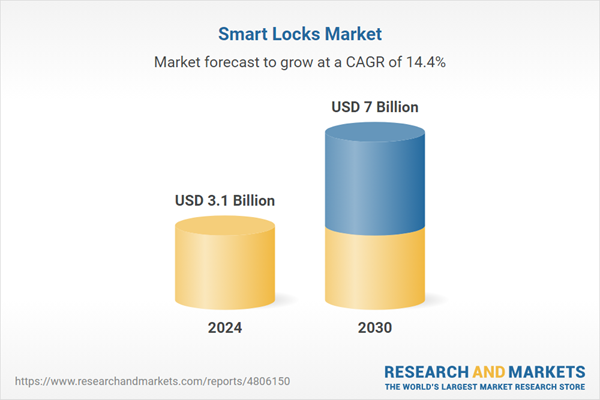The global market for Smart Locks was valued at US$3.1 Billion in 2024 and is projected to reach US$7.0 Billion by 2030, growing at a CAGR of 14.4% from 2024 to 2030. This comprehensive report provides an in-depth analysis of market trends, drivers, and forecasts, helping you make informed business decisions. The report includes the most recent global tariff developments and how they impact the Smart Locks market.
The innovation in smart lock technology continues to evolve, driven by advances in IoT connectivity and consumer demand for higher security and more convenient solutions. Modern smart locks offer features such as geofencing, which automatically locks or unlocks the door when the user's smartphone enters or leaves a predefined area, and tamper alarms that notify owners of attempted security breaches. The integration of AI and machine learning algorithms has also improved the functionality of these devices, enabling them to learn from user behavior and adjust settings accordingly for optimized security and energy efficiency. Furthermore, manufacturers are focusing on enhancing the aesthetic appeal of smart locks by offering a variety of styles and finishes that complement modern home décor, addressing consumer demand for technology that is not only functional but also visually pleasing.
The growth in the smart lock market is driven by several factors, including the expanding market for smart home devices, increased consumer focus on home security, and advancements in technology. As more consumers adopt smart home technologies, the demand for interconnected devices that provide enhanced control and monitoring capabilities continues to rise. Home security remains a primary concern for many households, and smart locks offer a technologically advanced solution that provides peace of mind with features like real-time alerts and secure remote access. Technological advancements such as improved battery life, easier installation processes, and better integration with other smart home technologies have made smart locks more appealing to a broader audience. Additionally, the growing popularity of rental and home-sharing services has fueled demand for smart locks, which provide a convenient and secure way for hosts to manage access to their properties. Economic growth and increasing urbanization in emerging markets also contribute to the expansion of the smart lock market, as new housing developments and modernization efforts often include upgrades to more advanced security systems. These factors collectively ensure robust growth in the smart lock market, reflecting its critical role in the evolving landscape of home security.
Segments: Lock Type (Deadbolts, Lever Handles, Padlocks, Other Lock Types); Vertical (Commercial, Residential, Institutional & Government, Industrial).
Geographic Regions/Countries: World; United States; Canada; Japan; China; Europe (France; Germany; Italy; United Kingdom; and Rest of Europe); Asia-Pacific; Rest of World.
The analysts continuously track trade developments worldwide, drawing insights from leading global economists and over 200 industry and policy institutions, including think tanks, trade organizations, and national economic advisory bodies. This intelligence is integrated into forecasting models to provide timely, data-driven analysis of emerging risks and opportunities.
Global Smart Lock Market - Key Trends & Drivers Summarized
Smart locks are an integral component of the modern smart home ecosystem, offering enhanced security and convenience through advanced technology. Unlike traditional locks, smart locks can be controlled remotely via smartphones, computers, or smart home systems, allowing users to lock and unlock doors without physical keys. These devices typically connect to home Wi-Fi networks or through Bluetooth, enabling features such as remote access, usage logs, and the ability to grant or deny access to others without the need for key duplication. Smart locks can also integrate with other smart home devices like cameras and voice assistants, providing a more comprehensive security system. User authentication methods in smart locks vary, incorporating mechanisms like passwords, biometric scanning, and voice recognition, which significantly enhance security compared to traditional lock-and-key systems by adding layers of encryption and smart technology defenses against unauthorized access.The innovation in smart lock technology continues to evolve, driven by advances in IoT connectivity and consumer demand for higher security and more convenient solutions. Modern smart locks offer features such as geofencing, which automatically locks or unlocks the door when the user's smartphone enters or leaves a predefined area, and tamper alarms that notify owners of attempted security breaches. The integration of AI and machine learning algorithms has also improved the functionality of these devices, enabling them to learn from user behavior and adjust settings accordingly for optimized security and energy efficiency. Furthermore, manufacturers are focusing on enhancing the aesthetic appeal of smart locks by offering a variety of styles and finishes that complement modern home décor, addressing consumer demand for technology that is not only functional but also visually pleasing.
The growth in the smart lock market is driven by several factors, including the expanding market for smart home devices, increased consumer focus on home security, and advancements in technology. As more consumers adopt smart home technologies, the demand for interconnected devices that provide enhanced control and monitoring capabilities continues to rise. Home security remains a primary concern for many households, and smart locks offer a technologically advanced solution that provides peace of mind with features like real-time alerts and secure remote access. Technological advancements such as improved battery life, easier installation processes, and better integration with other smart home technologies have made smart locks more appealing to a broader audience. Additionally, the growing popularity of rental and home-sharing services has fueled demand for smart locks, which provide a convenient and secure way for hosts to manage access to their properties. Economic growth and increasing urbanization in emerging markets also contribute to the expansion of the smart lock market, as new housing developments and modernization efforts often include upgrades to more advanced security systems. These factors collectively ensure robust growth in the smart lock market, reflecting its critical role in the evolving landscape of home security.
Report Scope
The report analyzes the Smart Locks market, presented in terms of units. The analysis covers the key segments and geographic regions outlined below.Segments: Lock Type (Deadbolts, Lever Handles, Padlocks, Other Lock Types); Vertical (Commercial, Residential, Institutional & Government, Industrial).
Geographic Regions/Countries: World; United States; Canada; Japan; China; Europe (France; Germany; Italy; United Kingdom; and Rest of Europe); Asia-Pacific; Rest of World.
Key Insights:
- Market Growth: Understand the significant growth trajectory of the Deadbolts segment, which is expected to reach US$3.8 Billion by 2030 with a CAGR of a 14.9%. The Lever Handles segment is also set to grow at 14.5% CAGR over the analysis period.
- Regional Analysis: Gain insights into the U.S. market, valued at $838.9 Million in 2024, and China, forecasted to grow at an impressive 16.1% CAGR to reach $1.3 Billion by 2030. Discover growth trends in other key regions, including Japan, Canada, Germany, and the Asia-Pacific.
Why You Should Buy This Report:
- Detailed Market Analysis: Access a thorough analysis of the Global Smart Locks Market, covering all major geographic regions and market segments.
- Competitive Insights: Get an overview of the competitive landscape, including the market presence of major players across different geographies.
- Future Trends and Drivers: Understand the key trends and drivers shaping the future of the Global Smart Locks Market.
- Actionable Insights: Benefit from actionable insights that can help you identify new revenue opportunities and make strategic business decisions.
Key Questions Answered:
- How is the Global Smart Locks Market expected to evolve by 2030?
- What are the main drivers and restraints affecting the market?
- Which market segments will grow the most over the forecast period?
- How will market shares for different regions and segments change by 2030?
- Who are the leading players in the market, and what are their prospects?
Report Features:
- Comprehensive Market Data: Independent analysis of annual sales and market forecasts in US$ Million from 2024 to 2030.
- In-Depth Regional Analysis: Detailed insights into key markets, including the U.S., China, Japan, Canada, Europe, Asia-Pacific, Latin America, Middle East, and Africa.
- Company Profiles: Coverage of players such as Honeywell International, Inc., Bioenable Technologies Pvt., Ltd., Allegion PLC, ASSA ABLOY AB, Anviz Global, Inc. and more.
- Complimentary Updates: Receive free report updates for one year to keep you informed of the latest market developments.
Some of the 96 companies featured in this Smart Locks market report include:
- Honeywell International, Inc.
- Bioenable Technologies Pvt., Ltd.
- Allegion PLC
- ASSA ABLOY AB
- Anviz Global, Inc.
- Bonda Technology Pte Ltd.
- Godrej Industries Ltd.
- Hudson Lock LLC
- Cansec Systems Ltd.
- Gantner Electronic GmbH
- Kisi, Inc.
- Dessmann Schliessanlagen GmbH
- Idency Limited
- D&K GmbH & Company KG
- Babuino S.r.l.
Tariff Impact Analysis: Key Insights for 2025
Global tariff negotiations across 180+ countries are reshaping supply chains, costs, and competitiveness. This report reflects the latest developments as of April 2025 and incorporates forward-looking insights into the market outlook.The analysts continuously track trade developments worldwide, drawing insights from leading global economists and over 200 industry and policy institutions, including think tanks, trade organizations, and national economic advisory bodies. This intelligence is integrated into forecasting models to provide timely, data-driven analysis of emerging risks and opportunities.
What’s Included in This Edition:
- Tariff-adjusted market forecasts by region and segment
- Analysis of cost and supply chain implications by sourcing and trade exposure
- Strategic insights into geographic shifts
Buyers receive a free July 2025 update with:
- Finalized tariff impacts and new trade agreement effects
- Updated projections reflecting global sourcing and cost shifts
- Expanded country-specific coverage across the industry
Table of Contents
I. METHODOLOGYII. EXECUTIVE SUMMARYIII. MARKET ANALYSISIV. COMPETITION
1. MARKET OVERVIEW
2. FOCUS ON SELECT PLAYERS
3. MARKET TRENDS & DRIVERS
4. GLOBAL MARKET PERSPECTIVE
UNITED STATES
CANADA
JAPAN
CHINA
EUROPE
FRANCE
GERMANY
ITALY
UNITED KINGDOM
REST OF EUROPE
ASIA-PACIFIC
REST OF WORLD
Companies Mentioned (Partial List)
A selection of companies mentioned in this report includes, but is not limited to:
- Honeywell International, Inc.
- Bioenable Technologies Pvt., Ltd.
- Allegion PLC
- ASSA ABLOY AB
- Anviz Global, Inc.
- Bonda Technology Pte Ltd.
- Godrej Industries Ltd.
- Hudson Lock LLC
- Cansec Systems Ltd.
- Gantner Electronic GmbH
- Kisi, Inc.
- Dessmann Schliessanlagen GmbH
- Idency Limited
- D&K GmbH & Company KG
- Babuino S.r.l.
Table Information
| Report Attribute | Details |
|---|---|
| No. of Pages | 328 |
| Published | April 2025 |
| Forecast Period | 2024 - 2030 |
| Estimated Market Value ( USD | $ 3.1 Billion |
| Forecasted Market Value ( USD | $ 7 Billion |
| Compound Annual Growth Rate | 14.4% |
| Regions Covered | Global |









